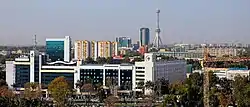Tashkent Tower
The Tashkent Television Tower (Uzbek: Toshkent Teleminorasi) is a 375-metre-high (1,230 ft) tower, located in Tashkent, Uzbekistan and is the twelfth tallest tower in the world. Construction started in 1978 and it began operation six years later, on 15 January 1985. It was the forth tallest tower in the world from 1985 to 1991. Moreover, the decision to construct the Tashkent Tower or TV-Tower of Uzbekistan was made on 1 September 1971 in order to spread the TV and radio signals to all over the Uzbekistan. It is of a vertical cantilever structure, and is constructed out of steel. Its architectural design is a product of the Terxiev, Tsarucov & Semashko firm.
| Tashkent TV Tower | |
|---|---|
 Tashkent Tower and skyline | |
| General information | |
| Type | TV-translation, Radio-translation, communication, hydrometeorological research |
| Location | Tashkent, Uzbekistan |
| Construction started | 1978 |
| Completed | 1984 |
| Height | |
| Antenna spire | 375 m (1,230.3 ft) |
| Top floor | 97 m (318.2 ft), observation deck |
| Technical details | |
| Lifts/elevators | 3 |
| Design and construction | |
| Architect(s) | Y.P. Semashko, I.N. Terziev-Tsarukov |
| Main contractor | E.P. Morozov, M.D. Musheev |
The tower has an observation deck located 97 metres (318 ft) above the ground. It is second tallest structure in Central Asia after Ekibastuz GRES-2 Power Station in Ekibastuz, Kazakhstan. It also belongs to the World Federation of Great Towers.
Use
The main purposes of the tower are radio and TV-transmission. The signal reaches the farthest points of Tashkent Province and some of the south regions of Kazakhstan. The tower is also used for communication between governmental departments, and organizations. The tower also serves as a complex hydrometeorological station.
.jpg.webp)